The Microsoft Surface Laptop 3 (15-Inch) Review: AMD Ryzen Surface Edition
by Brett Howse on October 21, 2019 9:00 AM EST- Posted in
- Laptops
- AMD
- Microsoft
- Surface
- Ryzen
- Surface Laptop
- Surface Laptop 3
Display Analysis
Microsoft continues to be one of the few PC manufacturers that calibrates all of their device displays, from the lowly Surface Go, all the way to the ultra-expensive Surface Studio range. They’ve also fully embraced the 3:2 aspect ratio for all devices, which initially made their convertible designs better at being convertible, but also makes for a better experience on the Surface Laptop. The Surface Laptop 3 features a 3:2 2496x1664 display, offering a 200 pxiels-per-inch density. With regards to calibration, Microsoft includes a sRGB calibration, as well as the “Enhanced” profile that was first introduced on the Surface Pro a few years ago, which doesn’t stick to sRGB exactly, but provides a bit richer color tones without affecting skin tones.
Microsoft also offers touch and pen support on the Surface Laptop 3. The touch works great, and pen support is also a nice option, although less useful than on something like the Surface Pro where you can use the display as a notebook. The Surface Laptop display only opens about 135°.
To see how the Surface Laptop 3 performs, it was tested with Portrait Display’s CalMAN software suite, along with an X-Rite i1Display Pro colorimeter for brightness and contrast testing, and an X-Rite i1Pro2 spectrophotometer for color accuracy assestment.
Brightness and Contrast
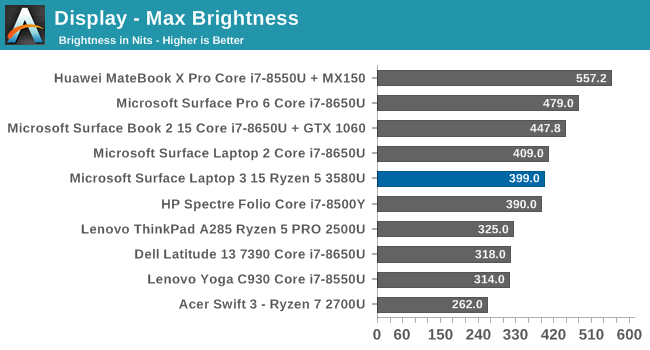
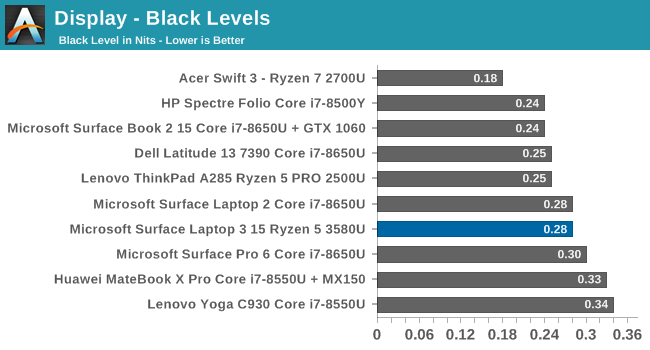
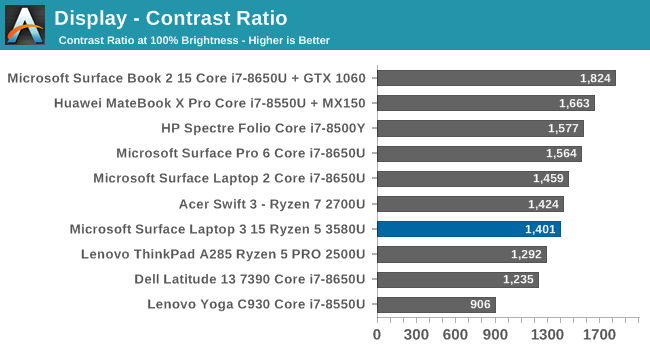
The Surface Laptop 3 gets reasonably bright, with up to about 400 nits of maximum brightness, but still offers great black levels, resulting in a solid 1400:1 contrast ratio. While not quite the contrast of a Surface Book, it’s still a great result. For those that are interested, the display will go all the way down to 4 nits at minimum brightness, so there’s a pretty wide range here.
Grayscale
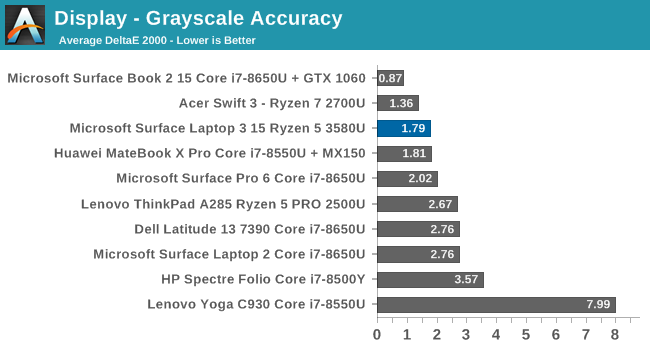
When evaluating grayscale, we’re looking for values under the 3.0 level to be basically imperceptible to the human eye, and the Surface Laptop 3 easily achieves that. At no point during the sweep did any of the gray levels exceed the 3.0 level, which is excellent. The gamma came in close to the 2.2 target as well.
Gamut
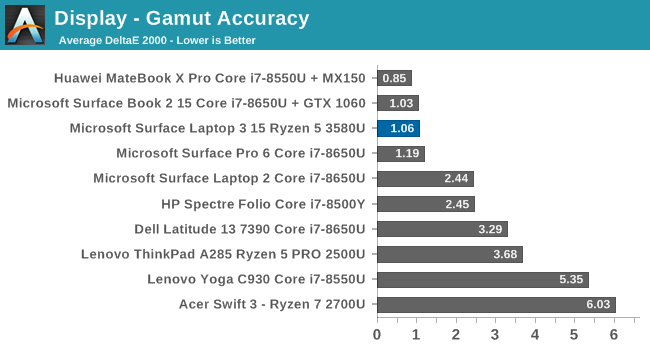
The gamut test highlights the primary and secondary colors at 100% brightness, and the Surface Laptop 3 performs very well here, with all of the colors coming in under an error level of 1.0 and providing full sRGB coverage.
Saturation
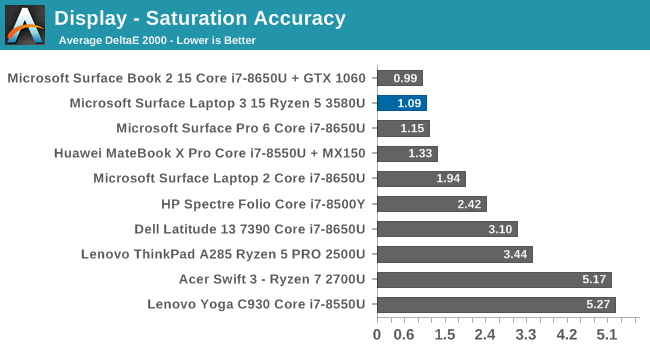
The saturation test is identical to the gamut test, but rather than testing at just 100% levels, the primary and secondary colors are tested in 4-bit steps from 0% all the way to 100%. The Surface Laptop 3 is almost perfect across the entire range, with yellow only being slightly over the 3.0 threshold for the first couple of steps.
Gretag Macbeth
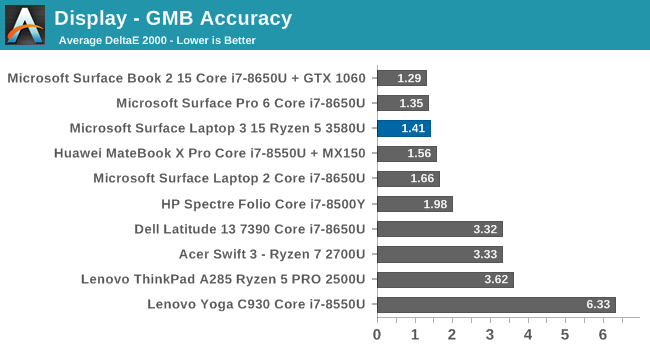
The Gretag Macbeth test expands the tested to color to those well off the primary and secondary color axis, and the Surface Laptop 3 is nearly perfect, with none of the tested colors coming in over the 3.0 limit of perception on the DeltaE 2000.
Display Conclusion
Microsoft continues to set a high bar in terms of displays. The Surface Laptop 3 doesn’t quite offer the resolution of the Surface Book series, but the IGZO display is finely tuned, offering near-perfect color calibration out of the box. Add in both touch and pen support, coupled with the excellent 3:2 aspect ratio, and the result is a delightful display, continuing the Surface tradition. It would be nice to see the Surface team move more towards wider gamut displays, and HDR as well, but until Windows solves its color management issues, that may not be as good of a solution as a properly done sRGB panel.


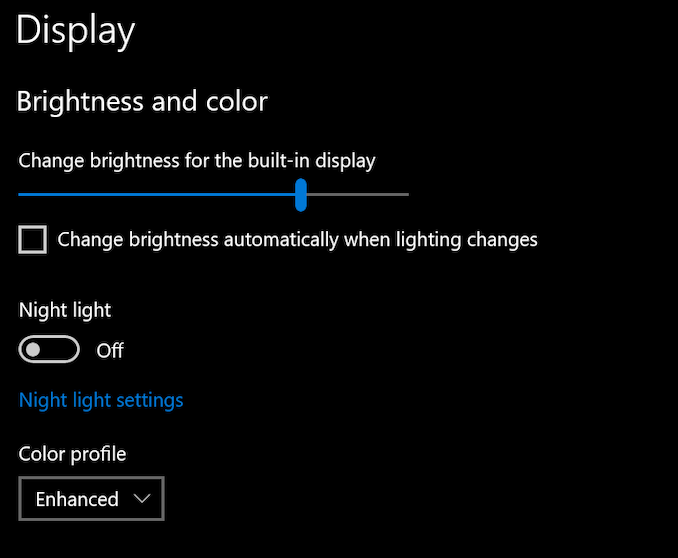












91 Comments
View All Comments
isthisavailable - Monday, October 21, 2019 - link
*just a comment sh*tting on MS for still having 128gb ssd as the base storage*isthisavailable - Monday, October 21, 2019 - link
And charging $300 for 128gb more! Seriously are they using optane or what for justifying such insane pricing because I can buy a 2tb ssd for $300.andykins - Monday, October 21, 2019 - link
Couldn’t agree more with this. Even Apple doesn’t charge that much for an SSD upgrade. The base model is good value but shame about the prices of the upgrades.isthisavailable - Monday, October 21, 2019 - link
Apparently SSD is upgradable. Time to swap it with a 2tb monster.tipoo - Monday, October 21, 2019 - link
It's swappable, but it's a rare form factor within m.2 and currently there aren't many (any?) replacement drives in this form factor.sing_electric - Tuesday, October 22, 2019 - link
THIS x 10^3. Keeping a 128GB base was one thing 2 years ago when NAND prices were still through the roof, but today? And their prices to upgrade are even more insane.At LEAST there's a few replacement boards available (like this Toshiba - 512GB for a reasonable $160: https://www.newegg.com/p/1B4-0016-03F41?item=9SIAH...
Hifihedgehog - Monday, October 21, 2019 - link
Excellent review as always, Brett! Is the Surface Pro 7 also in the pipeline for a review here? I'm quite curious to see your analysis of the GPU performance.Brett Howse - Monday, October 21, 2019 - link
Sorry I didn't get sampled that yet. Next up will be the Ice Lake XPS 13 though so stay tuned.nandnandnand - Monday, October 21, 2019 - link
https://wccftech.com/amd-4th-3rd-gen-ryzen-ryzen-t...Throw it into the garbage.
Let's see 6, 8, 10, or even 12 cores.
outsideloop - Monday, October 21, 2019 - link
Ice Lake is two pieces of silicon. Intel 10nm yields are low. Ice Lake is expensive to make, and that gets passed onto laptop price. Yes, the Ryzen is $1200. The Ice Lake models will be closer to $2000. How much do you want to spend?